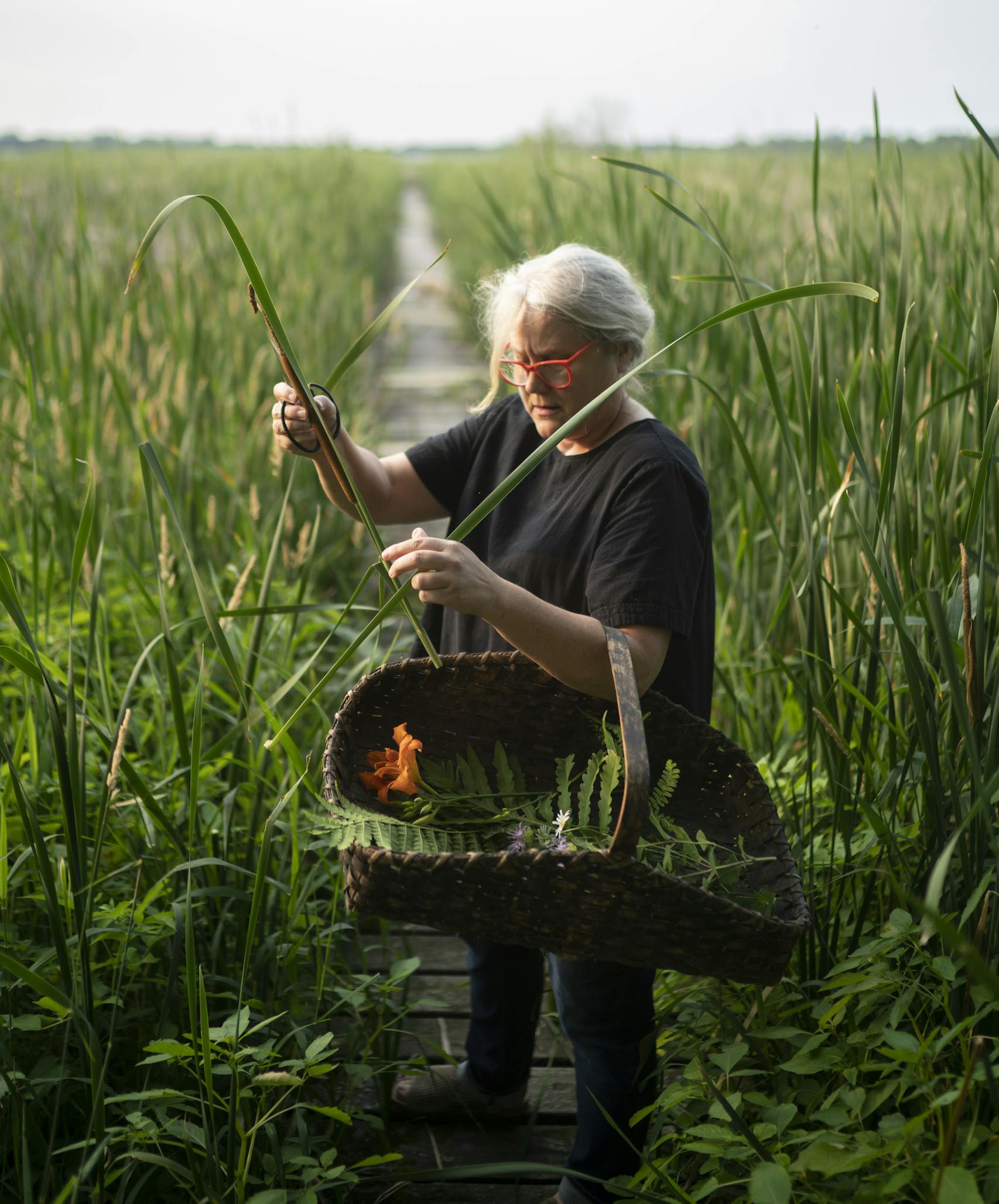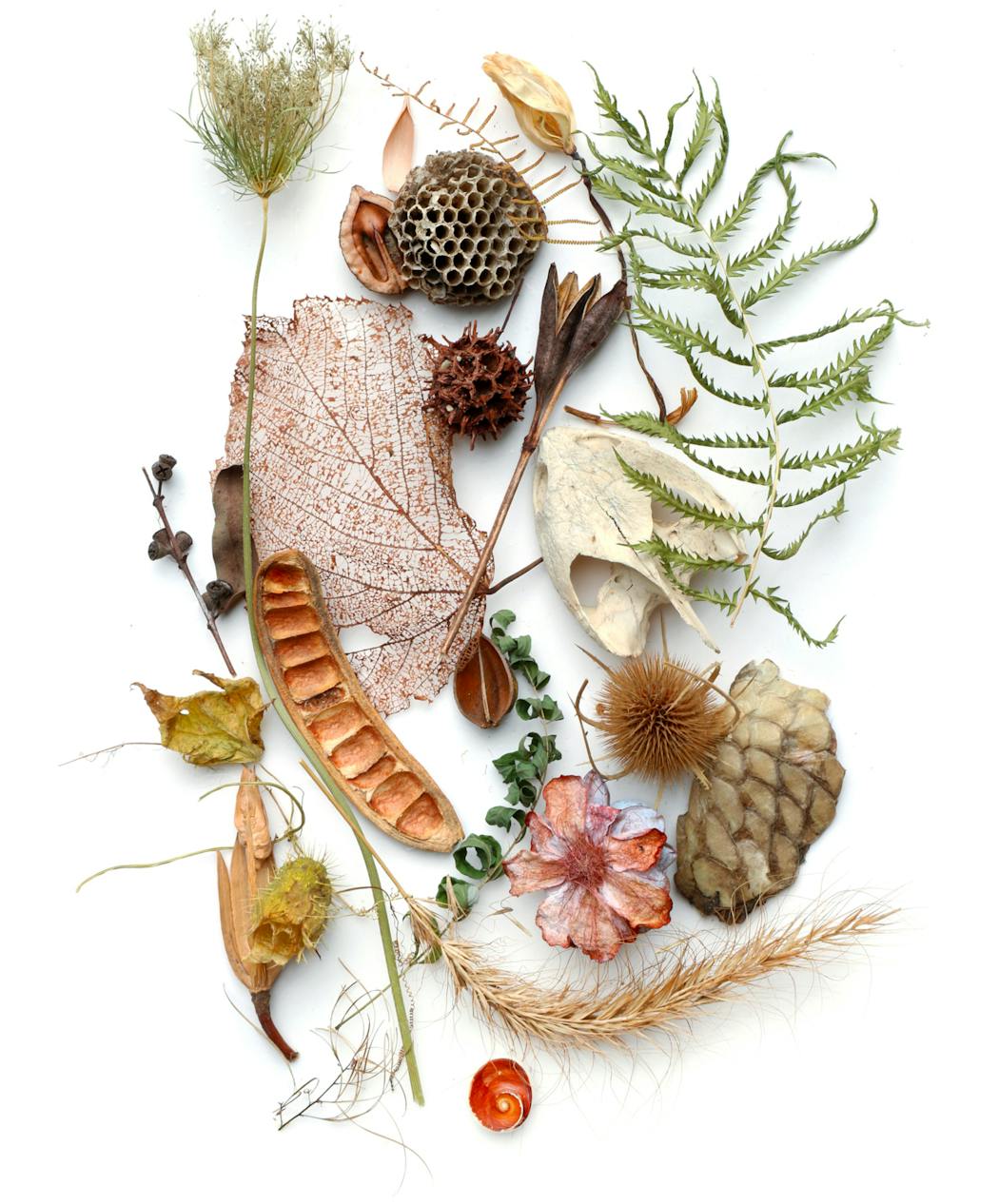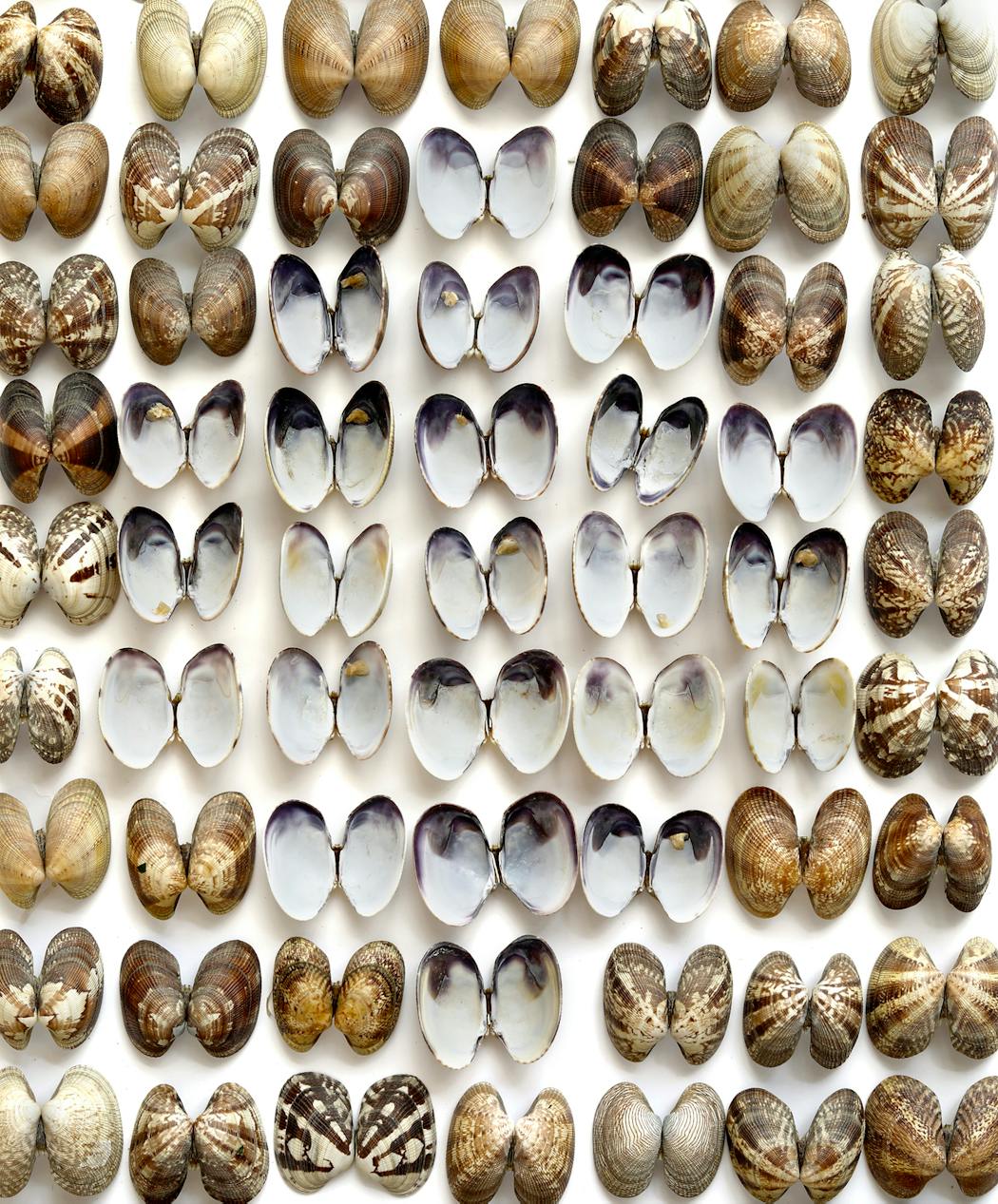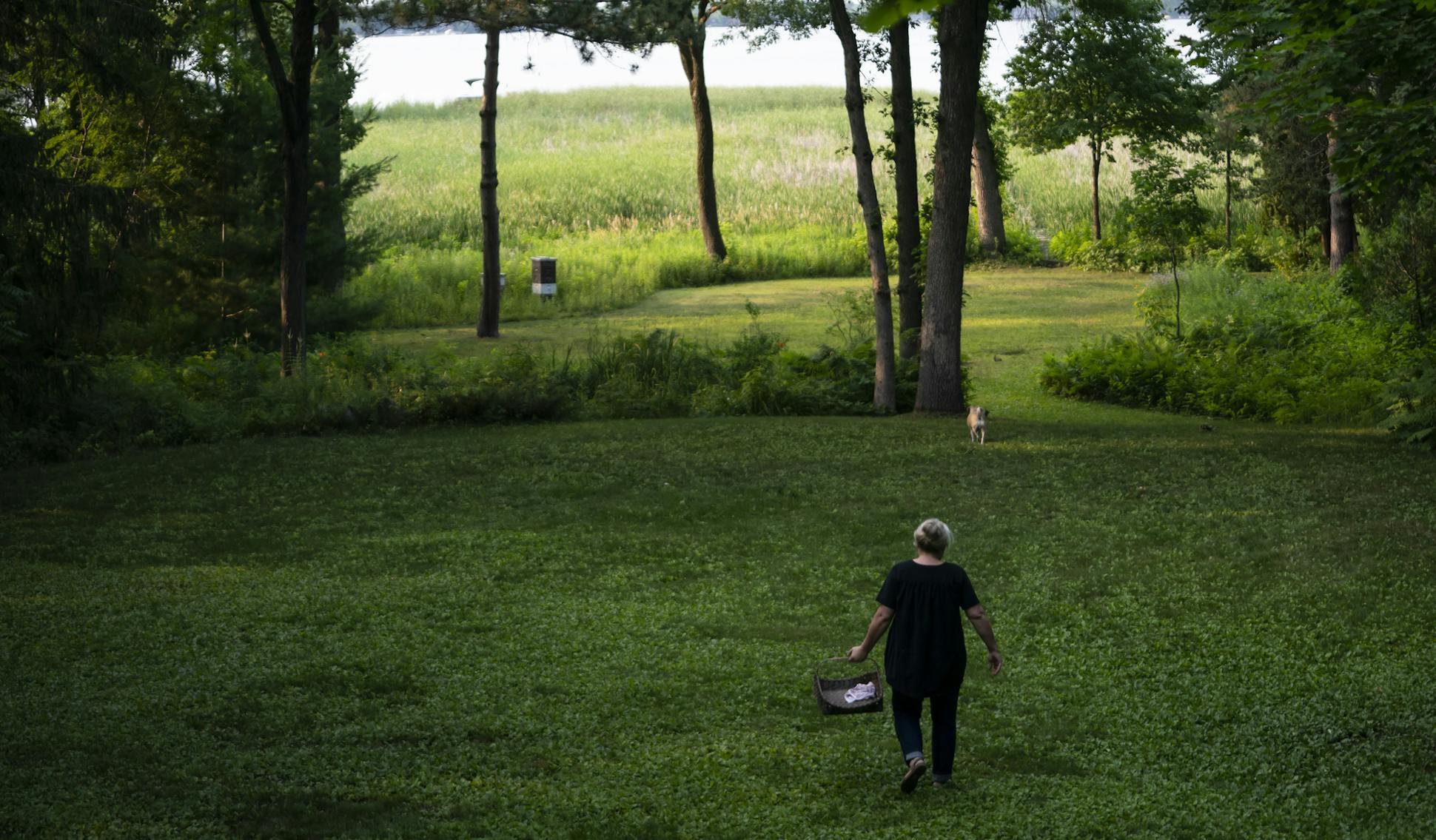athering basket tucked under her arm, florist scissors in hand, Mary Jo Hoffman sets out for the backyard. She lives in Shoreview, just 15 minutes from the downtowns of Minneapolis and St. Paul. But the family parcel on Turtle Lake, accessed by a long gravel driveway tunneling through woods, feels more like cabin country Up North. Birds call. Bees buzz. Speedboats, too.
As evening approaches, Hoffman, 57, scans the canvas of native plants, searching for photo subjects. She leans into a thicket and clips a past-its-prime daylily that's the same bright orange as her eyeglass frames. She collects a few daisies and bright-red baneberries. She marvels at a maidenhair fern's whirl of blades and tiny, gingko-shaped leaves.
Then the jaunty curve of a mysterious tendril catches her eye. "Now this is interesting," she says.
Snip. Into the basket it goes.
On Jan. 1, 2012, Hoffman, an aerospace engineer-cum-artist, started one of those trendy-at-the-time daily challenges: She'd make a photograph of found natural items and post it to her blog, called Still (stillblog.net). She began collecting pine cones and peonies and pussy willows. Then she'd arrange her subjects against a white backdrop, sometimes in rhythmic patterns, other times in abstractions. Then — click — she'd preserve the moment. Part phenologist, part aesthete.
A scroll through Still presents a digitized, stylized version of nature: the organic world, ordained by a graphic designer. Hoffman's work might be considered a mod, visual terroir of our northern biome. Or a nontraditional approach to the tradition of documenting nature — as if "Walden" or "Pilgrim at Tinker Creek" had an Instagram account.
Hoffman says she's no trendsetter, though evidence suggests the contrary. Target printed Still photos on pillows, sheets and shower curtains. West Elm sold prints. Still photos grace everything from book covers to the walls of fancy resorts to an LGBT film-festival poster in Serbia. They've inspired animated characters in an Israeli children's TV show and been inked into countless tattoos.
When Hoffman started Still, she thought she'd do it for a year. Then Martha Stewart Living wanted to do a feature and Hoffman figured she couldn't stop. Now, some 3,500 images in, Hoffman says she's kept at Still because stopping to look at the world changed how she lived in it.
"The reason I've been doing this for 10 years is that it really makes me pay attention," Hoffman says.
She's never missed a day.
The daily gather
With Jack the puggle at her heels, Hoffman heads down a wobbly dock stretching hundreds of feet through a swath of cattails.
Hoffman keeps a mental list of the seasonally changing state of her surroundings. Sometimes she captures plants in their full-blooming peak. But she's also drawn to dormant bulbs, rising shoots and petals in decay. She might reprise vibrant purple thistle blossoms a few days later, their dried heads gone to seed.
Hoffman doesn't shy away from capturing imperfection or sorrow, be it lacy, beetle-eaten leaves or a sparrow killed by her glass patio door.
She's honed her process over the years. A dog's nail clipper makes the best snipping tool. Milkweed never gets boring. And if she squirrels away material for the scarce winter, she can open her leaf press in December to work with last spring's itty-bitty oak and cottonwood leaves.
Hoffman discovered she liked the discipline of a daily creative practice and its impending, recurring deadline. Sometimes she makes several photos in one day, to have extras in the queue. But like an athlete in training, she starts to feel she's losing her edge if she skips photographing for more than a day or two.
Rarely does Hoffman find herself in the predicament of waning daylight with nothing in the can. Though in a moment of desperation she has been known to pick a dandelion and ask her husband, Steve, to hold it against his white T-shirt.
"When you're doing it every day like that, some days are very pedestrian," she says. "Not every day is artful, and that's kind of the fun of it. It's like doing scales. But then on some days magic happens."
A family affair
As the sun descends, Hoffman heads inside to grab a camera and tripod.
Her home shares her blog's airy, minimalist aesthetic: white everywhere and vaulted ceilings. Jazz plays. A bottle of rosé awaits. Paper hand-dyed with botanical inks, an artwork-in-progress commissioned by a nearby restaurant, covers the dining room table.
Evidence of Still is piled up near the grand piano. There's the vine-entagled nest a friend gave her. And a ghostly fish skull that Steve and their high schooler son, Joseph, brought back as her souvenir of a recent fishing trip.
In 2012, the hip New York website Design Sponge offered a peek into the Hoffman home, featuring the bed frame Steve made from two sections of dock and the sleeping porch he and Joseph inhabited through below-zero temps. The piece described how the family kept bees. And how when Eva, their now young-adult daughter, asked for a cellphone for her 13th birthday, she got a zipline instead. "In my next life, I want to come back as Mary Jo and Steve's kids," one commenter wrote.
The blog has become something of a family affair. Hoffman relies on her husband, whom she refers to as a "human Google," to help identify flora and fauna (years ago, Steve memorized the local library's entire audio collection of Minnesota bird calls). Joseph, a frequent supplier of blog fodder, once memorably rode up the driveway dangling a dead mole from his bicycle handlebars. "It ended up enhancing family life," Hoffman says of the project. "That was completely unexpected."
Hoffman maintains several ad hoc studios around the house, including the back deck, where she's set up today. She arranges the contents of her basket on a piece of white tagboard and points her camera top-down — the simple setup she favors, using only natural light. Hoffman also has a mobile studio (aka a piece of white tagboard in the back of her car) in case she spots something when she's out and about.
Her most memorable highways-and-byways encounter, on the way back from Joseph's piano lesson, was a lump of intact-looking roadkill. Despite the sleet, she photographed the already-stiff coyote on the side of the road, as traffic whizzed by. A close-up of the creature's snow-dappled ear now hangs above the fireplace.
"An otherwise forgettable object from the periphery of life, its beauty captured and elevated to the level of art by the simple act of noticing," is how the photo was described by the alumni magazine of Stanford University, where Hoffman earned a master's degree during her previous life as an aerospace engineer.
Prior to Still, Hoffman spent 15 years working on aviation guidance systems for Honeywell. She chose the career because she enjoyed solving challenging math problems, which came easily to her, "like doing crossword puzzles for some people," she explains.
But following Eva's birth, Hoffman quit that gig to focus on family and spent the next several years in Mom mode. After both kids were in school, she discovered blogging.
Hoffman conceived of Still as a project that she could fit into spare minutes throughout the day without interfering with kid and home responsibilities. She'd always enjoyed picking up natural ephemera (as her many Lake Superior rock collections and jars of feathers would attest) and could gather photo subjects while she walked the dog. The only flaw in her plan, she says, was starting a nature blog in Minnesota in January: "There's nothing except the twigs that stick out of the snow."
In a way, Still brought Hoffman back to her roots. She was raised not far from her current home, when newly incorporated Shoreview was empty lots of swamp and woods. "I grew up with what we call benign neglect," Hoffman cheerily recalls. "We were supposed to go outside to play and not come home till dinner."
A book of micro-seasons
Hoffman's next project is curating Still into a photo book, organized around the concept of the 72 "micro-seasons" delineated by ancient Chinese and Japanese calendars. The Japanese named each period by what it revealed: the days when mists start to linger, or when cicadas sing.
Hoffman created her own micro-season names, corresponding to her home bioregion: when crocus shoots push up thorough soil; sap begins to run; the breeze carries a lilac scent; blackberries fatten; blue jays molt; black walnuts thump to the ground; maple trees blaze.
Hoffman views her work, like her subjects, as part of a larger creative ecosystem. She says she doesn't see her photos as the final product, but almost like "building blocks" for other artists.
Laine Simpson, an interior designer with Level Five Designs in Raleigh, N.C., has used Hoffman's images in the public spaces of new apartment complexes around the country. Because the Still aesthetic is so unique, Simpson says, it's especially impactful on large wall installations: "People walk in and most of the time their first word is, 'Wow.' "
Patrick Pryor, owner of Minneapolis' Nolo Art Consulting, also incorporates Still photos in interiors and has found people respond to the sense of childlike wonder they evoke. "We get to vicariously hold up the tiniest, most amazing-colored tamarack needle, and we get to be filled with awe — again, and again, and again," he says.
Through Still, it's almost as if Hoffman has cultivated a superpowered vision to see things most of us don't, as we race through the world so caught up in ourselves that we're blind to our surroundings. In a world of ever-increasing stimuli — of honks and pings and bright lights — Hoffman shows others how to nurture quiet and solitude.
Steve, a lauded writer who documents food culture, believes that engaging with his wife's intimate, visual chronicle of our bioregion can help form a deeper connection to this place. "There are plenty of reasons not to love Minnesota," he says with a grin. "But when you fall in love, you know all the details."
And the power of Still's "thousands of small eye blinks," Hoffman says, is their cumulative weight.




